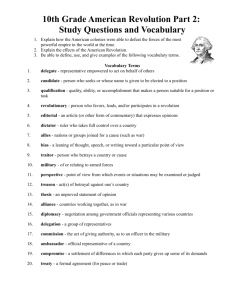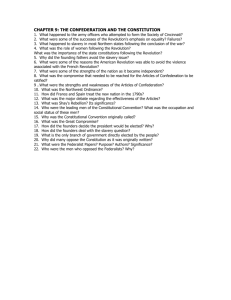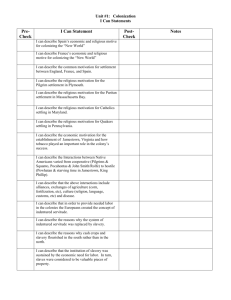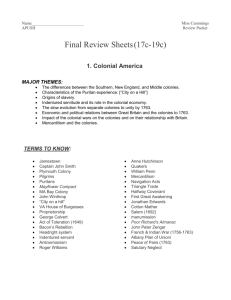Key Terms and Review Questions
advertisement
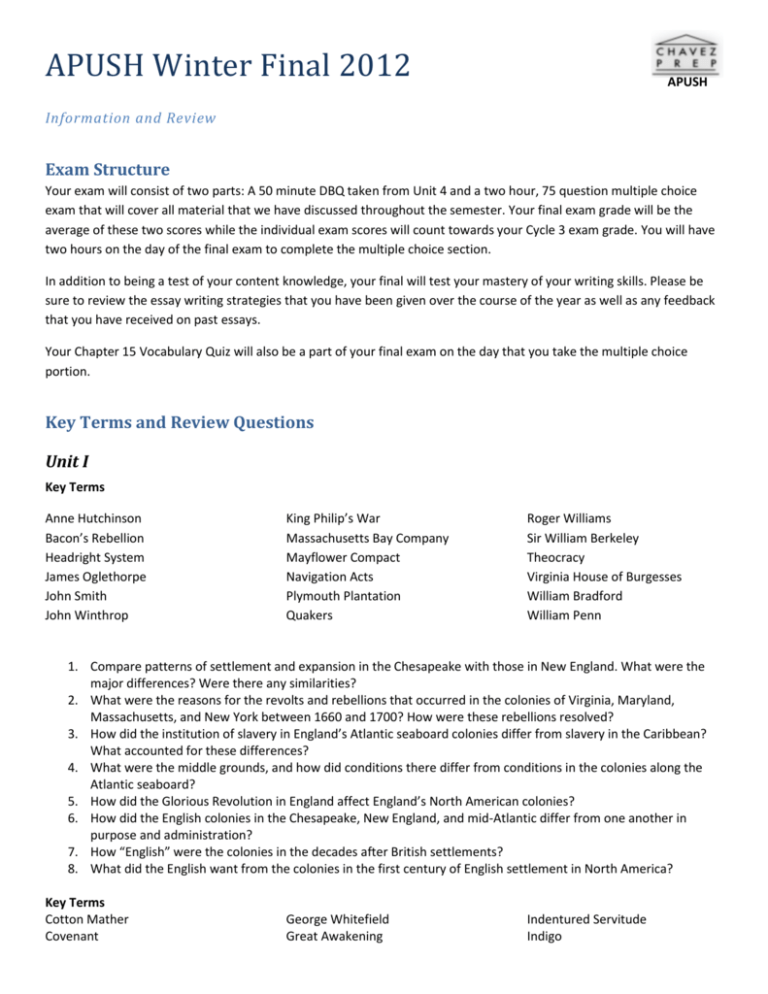
APUSH Winter Final 2012 APUSH Information and Review Exam Structure Your exam will consist of two parts: A 50 minute DBQ taken from Unit 4 and a two hour, 75 question multiple choice exam that will cover all material that we have discussed throughout the semester. Your final exam grade will be the average of these two scores while the individual exam scores will count towards your Cycle 3 exam grade. You will have two hours on the day of the final exam to complete the multiple choice section. In addition to being a test of your content knowledge, your final will test your mastery of your writing skills. Please be sure to review the essay writing strategies that you have been given over the course of the year as well as any feedback that you have received on past essays. Your Chapter 15 Vocabulary Quiz will also be a part of your final exam on the day that you take the multiple choice portion. Key Terms and Review Questions Unit I Key Terms Anne Hutchinson Bacon’s Rebellion Headright System James Oglethorpe John Smith John Winthrop King Philip’s War Massachusetts Bay Company Mayflower Compact Navigation Acts Plymouth Plantation Quakers Roger Williams Sir William Berkeley Theocracy Virginia House of Burgesses William Bradford William Penn 1. Compare patterns of settlement and expansion in the Chesapeake with those in New England. What were the major differences? Were there any similarities? 2. What were the reasons for the revolts and rebellions that occurred in the colonies of Virginia, Maryland, Massachusetts, and New York between 1660 and 1700? How were these rebellions resolved? 3. How did the institution of slavery in England’s Atlantic seaboard colonies differ from slavery in the Caribbean? What accounted for these differences? 4. What were the middle grounds, and how did conditions there differ from conditions in the colonies along the Atlantic seaboard? 5. How did the Glorious Revolution in England affect England’s North American colonies? 6. How did the English colonies in the Chesapeake, New England, and mid-Atlantic differ from one another in purpose and administration? 7. How “English” were the colonies in the decades after British settlements? 8. What did the English want from the colonies in the first century of English settlement in North America? Key Terms Cotton Mather Covenant George Whitefield Great Awakening Indentured Servitude Indigo John Peter Zenger Slave Codes The Enlightenment Jonathan Edwards Stono Rebellion Middle Passage Triangular Trade 1. How did patterns of family life and attitudes toward women differ in the northern and southern colonies? 2. How did the lives of African slaves change over the course of the first century of slavery? 3. Who emigrated to North America in the seventeenth century, and why did they come? 4. What was the intellectual culture of colonial America, as expressed in literature, philosophy, science, education, and law? 5. How and why did life in the English colonies diverge from life in England? 6. What accounted for the rapid increase in the colonial population in the seventeenth century? 7. Why did African slavery expand so rapidly in the late seventeenth century? 8. How did religion shape influence colonial society? Key Terms Albany Plan Benjamin Franklin Boston Massacre Boston Tea Party Charles Townshend Coercive Acts Committees of Correspondence Creoles Currency Act Daughters of Liberty First Continental Congress George Grenville Impressment Iroquois Confederacy Lord North Mutiny Act Patrick Henry Proclamation of 1763 Quebec Act Samuel Adams Sons of Liberty Stamp Act Stamp Act Congress Sugar Act Tea Act Townshend Duties William Pitt 1. How did the Seven Years’ War and its outcome affect Britain’s attitude and policies toward its North American colonies? 2. What Native Americans fought in the French and Indian War, and how did the war’s outcome affect them? 3. How and why did the colonists’ attitude toward Britain change from the time of the Seven Years’ War to the beginning of the American Revolution? 4. What were the philosophical underpinnings of the colonists’ revolt against Britain? 5. What did the slogan “No taxation without representation” mean, and why was it a rallying cry for the colonists? 6. What policies did Parliament implement with regard to the colonies in the 1760s and 1770s, and why did Britain adopt these policies? 7. How did the colonists respond to Parliament’s actions? Unit II Key Terms Articles of Confederation Lord Cornwallis Thomas Paine Common Sense Loyalists (Tories) Valley Forge Daniel Shays Olive Branch Petition William Howe George Washington Saratoga Yorktown Hessians Second Continental Congress John Locke Thomas Jefferson 1. What questions didthe Second Continental Congress debate, and how did it answer them? 2. What was the impact of Thomas Paine’s Common Sense on Americans’ view of the war with Britain? 3. How and why were the Americans able to prevail in their War for Independence? 4. What were the ideological ideals of the new state and national governments, and how did those ideals compare with the realities of American society? 5. What was the purpose of the Articles of Confederation? 6. How did the Revolution affect the role of religion and the position of churches in American society? 7. What were the military strategies (both British and American) of each of the three phase of the American Revolution? How successful were these strategies during each phase? 8. How did the new national government of the United States reflect the assumptions of republicanism? Key Terms Alexander Hamilton Great Compromise Revolution of 1800 Alien and Sedition Acts James Madison Separation of Powers Antifederalists Jay’s Treaty The Federalist Papers Bill of Rights John Adams Virginia and Kentucky Resolutions Checks and Balances New Jersey Plan Virginia Plan Citizen Genet Affair Pinckney’s Treaty Whiskey Rebellion Federalists Quasi War XYZ Affair Federalism Republicans 1. How did the Constitution of 1787 attempt to resolve the weaknesses of the Articles of Confederation? 2. What role did the Federalist Papers play in the battle over ratification of the Constitution? 3. What were the main tenets of Alexander Hamilton’s financial plan? 4. What diplomatic crises did the United States face in the first decade of its existence, and how did the new government respond to these crises? 5. What was the “Revolution of 1800” and in what way was it a revolution? 6. What were the most important questions debated at the Constitutional Convention of 1787, and how were they resolved? 7. What were the main tenets of the Federalist and Antifederalist arguments on ratification of the Constitution? 8. What were the origins of America’s “first party system”? Key Terms Aaron Burr John Marshall Tecumseh Deism Marbury v. Madison The Embargo Eli Whitney Noah Webster The Prophet Hartford Convention Robert Fulton Washington Irving Impressment Second Great Awakening William Henry Harrison 1. How successful was Jefferson’s effort to create a “republican” society dominated by sturdy, independent farmers? 2. How did the Napoleonic wars affect the United States? 3. What events and issues led to the War of 1812? 4. What was the impact of the Second Great Awakening on women, African Americans and Native Americans? 5. What was the long-term significance of the Marbury v. Madison ruling? 6. How did Americans respond to the Louisiana Purchase? 7. What foreign entanglements and questions of foreign policy did Jefferson have to deal with during his presidency? How did these issues affect his political philosophy? 8. What were the consequences of the War of 1812? Unit III Key Terms Adamis-Onis Treaty American System Francis Cabot Lowell Gibbons v. Ogden Henry Clay John Quincy Adams McCulloch v. Maryland Missour Compromise Monroe Doctrine Seminole War 1. How did the War of 1812 stimulate the national economy? 2. What were the reasons for the rise of sectional differences in this era? What attempts were made to resolve these differences? How successful were those attempts? 3. Why was the Monroe Doctrine proclaimed? 4. What was the significance of Andrew Jackson’s victory in the election of 1828? 5. How did the economic developments and territorial expansion affection American nationalism? 6. What was the “era of good feelings,” and why was it given that name? 7. How did the Marshall Court seek to establish a strong national government? Key Terms Andrew Jackson Bank War Daniel Webster “Five Civilized Tribes” Indian Territory John C. Calhoun John Tyler Martin Van Buren Nicholas Biddle Nullification Panic of 1837 Removal Act Roger B. Taney Seminole War Specie Circular Spoils System Trail of Tears Webster-Ashburton Treaty Webster-Hayne Debate Whigs William Henry Harrison 1. How did the electorate expand during the Jacksonian era, and what were the limits of that expansion? 2. What events fed the growing tension between nationalism and states’ rights, and what were the arguments on both sides of that issue? 3. What was the Second Party System, and how did its emergence and rise change national politics? 4. What was Andrew Jackson’s political philosophy, and how was it reflected in the policies and actions of his administration? 5. Who benefited under Jacksonian democracy? Who suffered? 6. How did Andrew Jackson change the office of the presidency? 7. Who supported and who opposed the Bank of the United States and why? Who was right? 8. How and why did white attitudes toward Native Americans change, and how did these changes lead to the Indian Removal Act and the Trail of Tears? Key Terms Cult of Domesticity Factory System Nativism Cyrus H. McCormick Know-Nothings Samuel F.B. Morse Erie Canal Lowell System 1. What were the political responses to immigration in mid-nineteenth-century America? Do you see any parallels to responses to immigration today? 2. Why did the rail system supplant the canal system as the nation’s major transportation network? 3. How did the industrial workforce change between the 1820s and the 1840s? What were the effects on American society of changes in the workforce? 4. How did America’s industrial revolution and the factory system change family life and women’s social and economic roles? 5. How did agriculture in the North change as a result of growing industrialization and urbanization? 6. What were the factors in the U.S. economic revolution of the mid-nineteenth century? 7. How did the U.S. population change between 1820 and 1840, and how did the population change affect the nation’s economy, society, and politics? 8. Why did America’s industrial revolution affect the northern economy and society differently than it did the southern economy and society? Key Terms Charles Grandison Finney Hudson River School Seneca Falls Edgar Allen Poe James Fenimore Cooper Shakers Elizabeth Cady Stanton Joseph Smith Susan B. Anthony Frederick Douglass Lucretia Mott Transcendentalism Harriet Beecher Stowe Margaret Fuller Walt Whitman Henry David Thoreau Nathaniel Hawthorne William Lloyd Garrison Herman Melville Ralph Waldo Emerson Horace Mann Sarah and Angela Grimke 1. How did an American national culture of art, literature, philosophy, and communal living develop in the nineteenth century? 2. What were the issues on which social and moral reformers tried to “remake the nation”? How successful were they? 3. Why did the crusade against slavery become the preeminent issue of the reform movement? 4. What arguments and strategies did the abolitionists use in their struggle to end slavery? Who opposed them and why? 5. What were the aims of the women’s movement of the nineteenth century? How successful were women in achieving these goals? 6. What is “romanticism” and how was it expressed in American literature and art? 7. How did religion affect reform movements, and what was the effect of these movements on religion? Unit IV Key Terms Abraham Lincoln Compromise of 1850 Dred Scott decision “Forty-Niners” Free Soil Party Gadsen Purchase General Antonio Lopez de Santa Anna Harpers Ferry James K. Polk John Brown Kansas-Nebraska Act Manifest Destiny Oregon Trail Popular Sovereignty Sam Houston Stephen A. Douglas Stephen F. Austin Tejanos The Alamo Treaty of Guadalupe Hidalgo Wilmot Proviso Winfield Scott “Young America” Zachary Taylor 1. How did the annexation of western territories intensify the conflict over slavery and lead to deeper divisions between the North and the South? 2. What compromises attempted to resolve the conflicts over the expansion of slavery into new territories? To what degree were these compromises successful? Why did they eventually fail to resolve the differences between the North and the South? 3. What were the major arguments for and against slavery and its expansion into new territories? 4. How were the boundary disputes over Oregon and Texas resolved? Why were the resolutions in the two cases so different? 5. How did Polk’s decisions and actions as president intensify the sectional conflict? 6. What was the issue at stake in “Bleeding Kansas,” and how did events in Kansas reflect the growing sectional division between the North and South? 7. What was the Dred Scott decision? What was the decision’s impact on the sectional crisis? 8. How did the growing sectional crisis affect the nation’s major political parties? Key Terms Abraham Lincoln Antietam Appomattox Court House Bull Run Clara Barton Emancipation Proclamation Fort Sumter George B. McClellan Gettysburg Greenbacks Homestead Act March to the Sea Morrill Land Grant Act Robert E. Lee Shiloh Thomas “Stonewall” Jackson Ulysses S. Grant U.S. Sanitary Commission William Tecumseh Sherman 1. How did the North’s mobilization for war differ from mobilization in the South? What accounts for these differences? 2. What were the differences between the impact of the war in the North and the South? 3. What were the military strategies employed by the North and the South from the opening clashes in 1861 through the Union victory in 1865, and how did these strategies differ? 4. Assess the advantages of the North and those of the South at the beginning of the Civil War. How did the advantages of each side change over the course of the war? 5. How did the Confederate government differ from the federal government of the United States? 6. How did the Civil War affect the West? 7. How did the war affect the lives of women in the North and in the South? 8. Why did Lincoln issue the Emancipation Proclamation and what were its effects? Key Terms Andrew Johnson Atlanta Compromise Black Codes Booker T. Washington Carpetbaggers Charles Sumner Compromise of 1877 Fourteenth Amendment Freedmen’s Bureau Ida B. Wells Jim Crow Laws Ku Klux Klan Panic of 1873 Plessy v. Ferguson Radical Republicans Redeemers Scalawags Sharecropping Thaddeus Stevens William Seward 1. 2. 3. 4. 5. 6. What were the principal questions facing the nation at the end of the Civil War? What were the achievements of Reconstruction? Where did it fail and why? What new problems arose in the South as the North’s interest in Reconstruction waned? What was the Compromise of 1877, and how did it affect Reconstruction? How did the New South differ from the South before the Civil War? What were the various plans for Reconstruction proposed by Lincoln, Johnson, and Congress? Which plan was enacted and why? 7. What were the effects of Reconstruction for blacks and whites in the South? 8. What were the political achievements and failures of the Grant administration?


